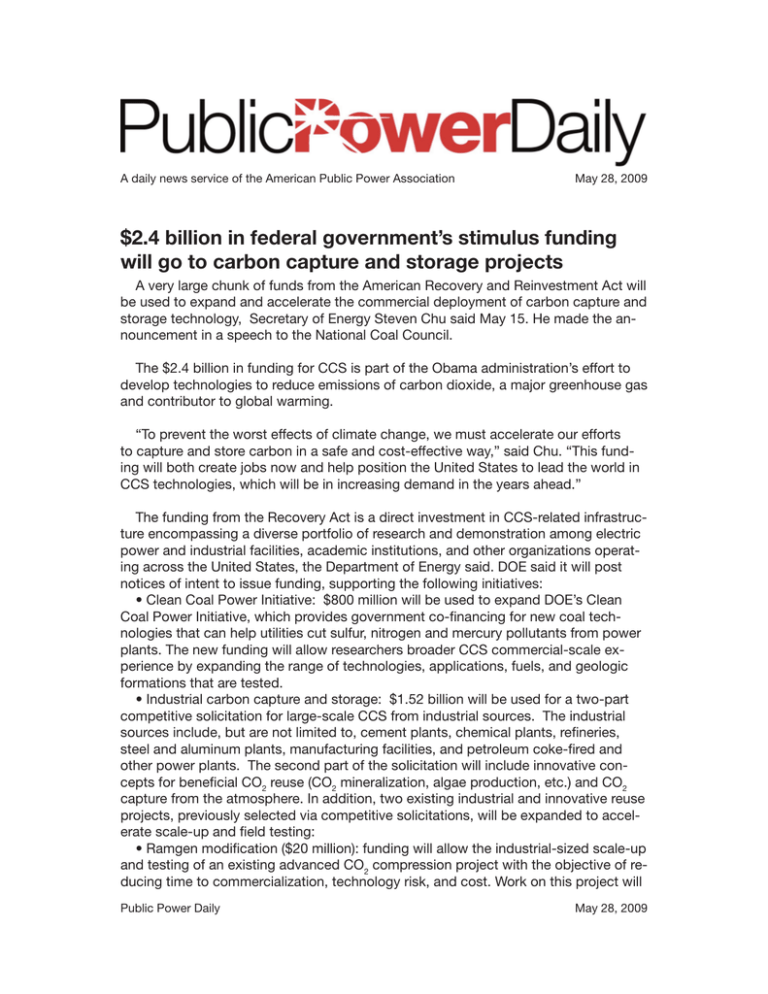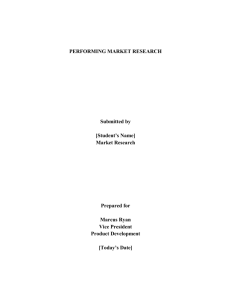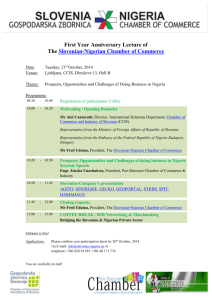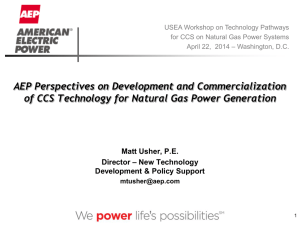$2.4 billion in federal government’s stimulus funding
advertisement

A daily news service of the American Public Power Association May 28, 2009 $2.4 billion in federal government’s stimulus funding will go to carbon capture and storage projects A very large chunk of funds from the American Recovery and Reinvestment Act will be used to expand and accelerate the commercial deployment of carbon capture and storage technology, Secretary of Energy Steven Chu said May 15. He made the announcement in a speech to the National Coal Council. The $2.4 billion in funding for CCS is part of the Obama administration’s effort to develop technologies to reduce emissions of carbon dioxide, a major greenhouse gas and contributor to global warming. “To prevent the worst effects of climate change, we must accelerate our efforts to capture and store carbon in a safe and cost-effective way,” said Chu. “This funding will both create jobs now and help position the United States to lead the world in CCS technologies, which will be in increasing demand in the years ahead.” The funding from the Recovery Act is a direct investment in CCS-related infrastructure encompassing a diverse portfolio of research and demonstration among electric power and industrial facilities, academic institutions, and other organizations operating across the United States, the Department of Energy said. DOE said it will post notices of intent to issue funding, supporting the following initiatives: • Clean Coal Power Initiative: $800 million will be used to expand DOE’s Clean Coal Power Initiative, which provides government co-financing for new coal technologies that can help utilities cut sulfur, nitrogen and mercury pollutants from power plants. The new funding will allow researchers broader CCS commercial-scale experience by expanding the range of technologies, applications, fuels, and geologic formations that are tested. • Industrial carbon capture and storage: $1.52 billion will be used for a two-part competitive solicitation for large-scale CCS from industrial sources. The industrial sources include, but are not limited to, cement plants, chemical plants, refineries, steel and aluminum plants, manufacturing facilities, and petroleum coke-fired and other power plants. The second part of the solicitation will include innovative concepts for beneficial CO2 reuse (CO2 mineralization, algae production, etc.) and CO2 capture from the atmosphere. In addition, two existing industrial and innovative reuse projects, previously selected via competitive solicitations, will be expanded to accelerate scale-up and field testing: • Ramgen modification ($20 million): funding will allow the industrial-sized scale-up and testing of an existing advanced CO2 compression project with the objective of reducing time to commercialization, technology risk, and cost. Work on this project will Public Power Daily May 28, 2009 be done in Bellevue, Wash. • Arizona Public Service modification ($70.6 million): funding will permit the existing algae-based carbon mitigation project to expand testing with a coal-based gasification system. The goal is to produce fuels from domestic resources while reducing atmospheric CO2 emissions. The overall process will minimize production of carbon dioxide in the gasification process to produce a substitute natural gas from coal. The host facility for this project is the Cholla Power Plant in Holbrook, Ariz. • Geologic sequestration site characterization: $50 million will fund a competitive solicitation to characterize a minimum of 10 geologic formations throughout the United States. Projects will be required to complement and build upon the existing characterization base created by DOE’s Regional Carbon Sequestration Partnerships, looking at broadening the range and extent of geologic basins that have been studied to date. The goal of this effort is to accelerate the determination of potential geologic storage sites. • Geologic sequestration training and research: $20 million will be used to educate and train a future generation of geologists, scientists, and engineers with skills and competencies in geology, geophysics, geomechanics, geochemistry and reservoir engineering disciplines needed to staff a broad national CCS program. This program will emphasize advancing educational opportunities across a broad range of minority colleges and universities and will use DOE’s University Coal Research Program as the model for implementing the program. DOE’s Recovery Act projects “will stimulate private sector infrastructure investments due to the significant amount of cost sharing that will occur in all large-scale projects to be selected for implementation,” the Energy Department said. The combined public and private investments “will establish a proving ground for creating a safe, reliable, widely available, environmentally responsible and affordable CCS infrastructure,” DOE said. –JEANNINE ANDERSON Chamber of Commerce points out obstacles to new energy projects, wants Congress to help The U.S. Chamber of Commerce has launched an effort to expose what it calls “a vast number” of energy projects in the United States that have been delayed or stopped because of permitting and siting hurdles, opposition by local and professional activist groups, and other obstacles. The chamber has created a Web site for its new campaign, “Project No Project,” that lists energy infrastructure projects the chamber says are being thwarted “at a time when our economy needs them most.” The Chamber of Commerce said it would run paid advertisements and use social networking sites to promote its message that Congress should pass legislation to make it easier for energy projects, including power plants and transmission lines, to be built. Public Power Daily May 28, 2009 “We cannot mandate excessive reductions in greenhouse gases, fuel our future, and apply green technologies if we don’t address the ‘green tape,’ excessive permitting requirements, and activist opposition,” said William Kovacs, vice president of environment, technology and regulatory affairs for the U.S. Chamber of Commerce. “By far the largest hurdle to developing energy in this country—of any kind—is the ludicrous amount of time it takes to obtain permits and related approvals for a new project,” Kovacs said. “When you factor in NIMBYs [not in my back yard], the problem becomes insurmountable,” he said. “Lawsuits drag on, zoning laws are changed, financing dries up, and ultimately projects stop. All of this is killing jobs and threatening our economic recovery.” Project No Project highlights Cape Wind, the nation’s first proposed offshore wind farm planned for Nantucket Sound, Mass., as a project that can’t get off the ground because of opposition by activist groups. At peak capacity, Cape Wind would generate 420 MW of renewable electricity—enough to meet the needs of 420,000 homes. Other examples include coal-fired power plants, including one that American Municipal Power-Ohio plans to build in Meigs County, Ohio, a biomass power plant in Tallahassee, Fla., and a waste-to-ethanol plant in San Pierre, Ind. “All types of clean energy projects, from renewables to clean coal to natural gas, find themselves mired in green tape because of an inefficient permitting process,” the Chamber of Commerce says on its Project No Project Web site. “This process is susceptible to abuse by radical environmental activists and their not in my back yard allies, who actively work to block or cancel clean energy projects.” People who visit the Web site are invited to contribute their own stories of projects that have been delayed or canceled. –JEANNINE ANDERSON Public Power Daily is produced by the editorial staff of Public Power Weekly newsletter. Subscribers are prohibited from reproduction of this publication by any means, including facsimile or e-mail transmission, without the express permission of the American Public Power Association, except that it may be reproduced and/or redistributed to employees or board members of their own organizations. Questions or comments about editorial matter should be directed to Jeannine Anderson (janderson@APPAnet.org, or call 202/467-2977). Subscription inquiries should be directed to Susan Lynch (slynch@APPAnet.org, or call 202/467-2970). The subscription price for non-members is $290/year for delivery via e-mail; $570/year for delivery via fax. Copyright © 2009, American Public Power Association Public Power Daily May 28, 2009 SAVE THE DATE June 12–17 2009 APPA NATIONAL CONFERENCE S A LT L A K E C I T Y, U TAH APPA NATIONAL CONFERENCE & PUBLIC POWER EXPO JUNE 15–17, 2009 SALT PALACE CONVENTION CENTER SALT LAKE CITY, UTAH PUBLIC POWER DAY OF GIVING JUNE 12, 2009 PRE-CONFERENCE SEMINARS JUNE 13–14, 2009 For more information, visit “Events” at www.APPAnet.org. Public Power Daily May 28, 2009







